Instruction
Which putting grip improves the average golfer’s alignments?
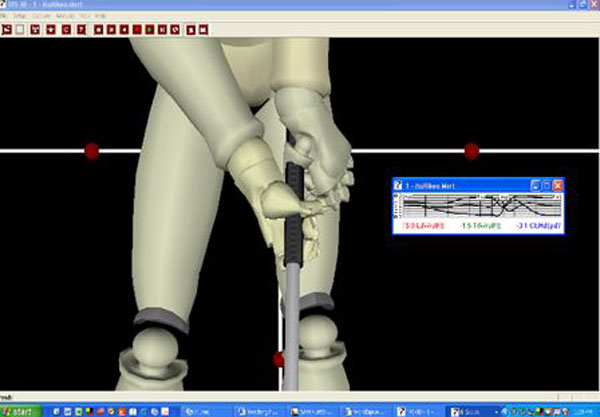
I’ve found that the most damaging flaw within a golfer’s putting is the breakdown of the lead wrist through impact. This flaw causes many more problems than anything else for the average golfer’s putting such as adding loft to the putter through impact, poor impact points on the face, incorrect pace control, loss of feel, loss of confidence and faulty impact alignments and subsequent aim. If I had to point to one move that will cause your putting stroke, confidence and ability to hole putts consistently to implode it would be this move.
Within my putting academy, I use computer systems that can track motions of the body and putter. Advanced Motion Measurement’s 3D Motion Analysis System will track the motions of the wrists comparing them at address and impact, while the SAM Puttlab will track the motions of the putter head during impact.
Below, I have charted the performance characteristics in impact aim and the shaft angle at impact (which determines the impact alignments and the subsequent breakdown of the wrists) of 10 different grip. I’ve also tested players of each level and average their results within their handicap levels to give a general idea of what happens during the stroke. The handicap levels will be as follows: tour professional, scratch, 10, 18, 25 and 36.
The 10 Grips
- A “normal” putting grip
- The interlocking grip
- The overlapping grip
- The reverse-overlapping grip
- The reverse-overlapping grip with index finger extended
- The baseball grip
- The split baseball grip
- The left hand low grip
- The claw grip
- Bernhard Langer’s long left arm grip
- Strong rear hand grip
Desired impact alignments and terminology
The Goal at Impact is as flat forward wrist, a bent rear wrist and a neutral to slightly forward-leaning club shaft.
The Goal of Dynamic Loft During Impact is to preserve the static loft of the putter at impact so that the shaft angle is “0.”
Impact Aim is the direction that the putter face is aiming at impact. This factor determines 83 percent of the ball’s direction and can either be either open (O) or closed (C). If you cannot control the putter’s alignments during impact, then you will never be able to begin the ball on your intended line consistently. That means you will have a hard time making putts.
Shaft Lean is the amount of positive or negative “lean” of the club shaft at impact. If the putter shaft is leaning forward at impact, it will deloft (D) the putter’s static loft. If it is leaning backward at impact, it will add (A) to the putter’s static loft. We would like the putter to be relatively neutral at impact or very close to it. When the wrists are too active, the lead wrist breaks down adding loft to the putter during impact. This causes the ball to hop and skip, making feel and distance control inconsistent.
The Test

There is little change from address aim to impact aim in the tour professional.
One can derive several observations from the tour professional data above. Tour professionals, as you can imagine, aim the putter very close to where they are trying to at address, but not perfectly. At impact, any aiming deficiencies are accounted for. Thus, the ball leaves the blade on the chosen target line and this is the reason why these players are so good at controlling the ball’s starting direction. The putter’s shaft lean is basically neutral, helping the ball to leave the blade with the perfect roll characteristics using the loft designed into the putter naturally.
An impact alignment breakdown for the professional player does not happen too often. If anything, they ensure that they are not delofting the putter too actively during impact and do their best to make sure the loft of their putter remains relatively constant at the impact position. If they consistently deloft the putter through impact to a great degree, then they must add loft to their putters accordingly.
In regards to impact aim at the scratch level, there are not too many difference between each grip, however, when the “claw and Langer” grips are used, the shoulder rotation at impact seems to increase. When the shoulders are overactive during impact, it tends to cause the putter to close too rapidly. These players tend to move the ball back in their stance to accommodate this shoulder action.
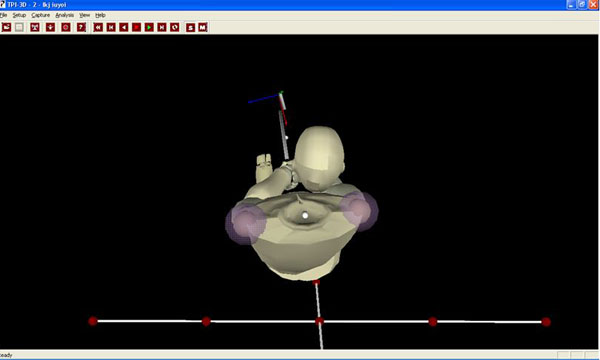
When the “claw or Langer” grips are used the shoulders can become too overactive rotationally as shown above shutting down the blade at impact; thus, the ball position should be moved slightly back in the stance to accommodate.
As we examine the impact alignments and their effect on the effective loft of the putter, you will see that the scratch players, just like the tour professionals, must make sure that they are not leaning the shaft too far forward during impact and driving the ball into the ground.
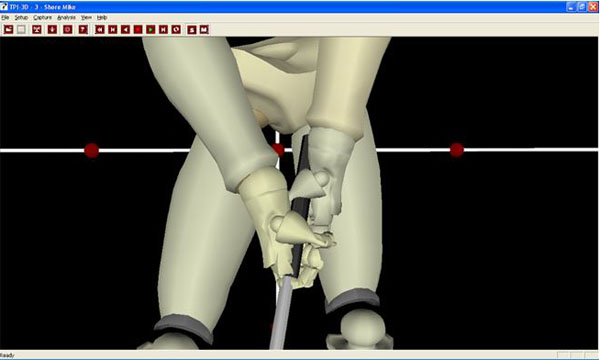
When the putter shaft leans too far forward (as shown above) it can lead to the ball being driven into the ground through impact. Skidding and bouncing can result.
The only grip type that tends to consistently deloft the putter to an exaggerated degree on average is the split grip. This, in my opinion, is due to the shaft being set more forward at the address position, and why goflers such as Natalie Gulbis must make sure that they have more loft to their putters than most golfers. This added loft will correct for the extra shaft lean at impact and give these players a better chance for the ball to react favorably at impact.
As the level of handicap goes up, you will find that impact aim and impact alignments begin to suffer. This is why higher-handicap golfers are generally less consistent on the greens than the scratch players. These two factors cause a number of short birdie and par putts to be missed, driving up the scores of these players. From tee to green, the 10 handicap and the 18 handicap golfers are not too far off from one another, except for a few more loose shots by the 18-handicap player. But the number of missed up-and-downs goes up dramatically as these short putts are missed.
The impact aim of both levels of players shows that the “claw and the cross-handed grip” are the most accurate. This, in my opinion, is due to the fact that with the “claw” the rear forearm is more on-plane. That contributes to better putter face control since the path is usually better with this type of grip. When the rear forearm rides “high” or above the club shaft — as seen in the graphic below — the impact aim and the path are negatively affected. The “claw and cross-handed” place the rear forearm in a much more consistent position than the other normal putting grips, and this is what the data above shows in a number of players.

When the rear forearm is too high as shown above the impact aim of the putter tends to be closed and the ball misses left as a result.
From an impact alignment standpoint, these higher-handicap players are the ones who are just beginning to show some added hand action through impact, adding effective loft to their putters. When this occurs, the ball will tend to hop into the air at the start of its movement toward the hole, causing inconsistencies. This “jumping” causes many reactions of the ball to occur.
It is just this little bit of hand action and “skipping” of the ball that causes golfers to miss a number of very makeable putts: ones that the lower handicap players would tend to make. As you can see from the data, the best grip for reducing hand action in these players would be the Langer grip, with the left arm on the shaft itself. Golfers will find that if they have issues on short putts, they can very easily keep the putter shaft in a consistent position through impact with the Langer grip, allowing the ball to react the same way on putts of a certain length. I would suggest trying this grip on putts inside 12 feet if you have trouble maintaining a solid “rolling” of the ball off the start. The Langer grip is also good for golfers with the “yips,” which seem to affect this player grouping more than any other.
In my studies, the only real difference between the putting abilities of 25-handicap and 36-handicap golfers is the former group’s ability to monitor and control their hand action. These players have a slightly better time controlling their hand action than the 36-handicappers, thus any type of grip that allows them to monitor their hand action will work more effectively.
The two grip styles that control their impact aim are the two that allow them to monitor their hands more than any other:
- The reverse overlap with the rear index finger down the shaft
- The split grip.
The rear index finger is the most used finger on the human body, and its ability to sense and control what it is doing is one of the keys to putting at this level. As golfers extend this finger, they will find that the motions of the putter head are easily controlled. This is why the 25-handicap golfer has better success with this type of grip when it comes to impact aim. However, this rear finger grip can also lead to overuse. This is shown above by grip’s inability to help reduce impact alignment breakdown.
The reverse overlap grip with the rear finger down the shaft is one of the worst grips when it comes to preserving the static loft of the putter during impact. When the rear index finger is allowed to over control the motions of the putter, golfers will find that it will cause their impact alignment breakdown and add shaft lean at impact. When this occurs, golfers will not be able to control their speed and therefore will have little feel on the greens.
This explains why 25-handicap golfers can three-putt from just about any distance and at just about any time during the round. That said, it is easier for the 25 handicapper to reduce his number of three-putts in order to reduce his score than to work on making more short putts, the exact opposite case for lower-handicap golfers.
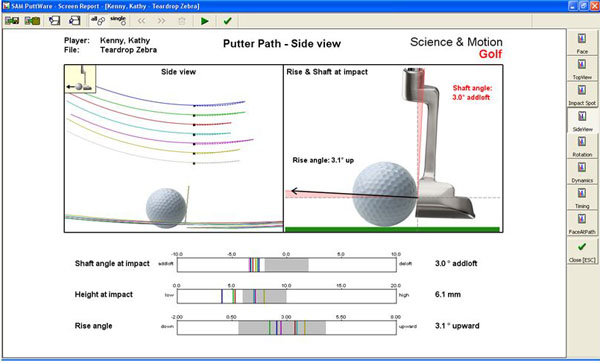
The 25-handicap golfer is guilty of adding too much loft to his putter when the reverse overlap with the index finger is extended grip is used.
When you examine the data tendencies in the 36-handicap golfer, you will see one thing in both categories: random data. This shows that this level of player has virtually little feeling or consistency in making the same type of stroke. This explains the golfer’s inability to control his or her speed or line on any type of putt.
One thing of note from the data, however, is that the “overlapping” grip — the same one generally used in the full swing — produced slightly better numbers for 36-handicap golfers. This is because this type of player uses this grip most often on the course, and generally has developed more feel with the grip than any other. Whenever these players are asked to change to a different putting grip, their feel tends to implode. Any grip other than the one they use most often can cause more inconsistent results.
These golfers must understand that the forward hand controls the rotation of the putter face and its alignments, while the rear hand and the bending of the rear wrist controls the shaft lean at impact and their subsequent feel. Anything other than a flat forward wrist and a bent rear wrist at impact will cause impact alignments and impact aim to be compromised. This is the most important lesson for the beginning golfer to understand and learn. Putting drills that involve each hand individually will help these players better understand the role of each hand during the putting stroke in order to have the proper alignments.
Conclusion
As with the full swing, different problems arise in putting for each handicap level of golfer. The higher the handicap, the less ball control the player has and the more important the understanding of the necessary impact alignments is for success. The better the player, the more important the proper aim of the putter is at impact. This is where a proper putter fitting and and properly weighted putter can really make a difference.
Higher-handicap golfers seem to three-putt more often because a lack of consistent shaft lean, which leads to poor feel and pace control. Lower-handicap golfers tend to miss makeable putts for pars and birdies because of poor impact alignments and aiming. Tour professionals understand subconsciously how to hit the ball where they want, and are able to put the shaft in the correct position more than lesser-talented golfers. That’s the main reason why they are more consistent.
As the data shows, different putting grips will work best for golfers of different ability levels, and it is necessary for golfers and their instructors to analyze their misses so that they can choose the correct grip. Sometimes direction is a problem, while other times feel is a problem. There are some grips that are better for directional control while others are better in controlling a golfer’s impact alignments. It is up to you to determine your problems and pick the right grip style accordingly.
- LIKE24
- LEGIT4
- WOW9
- LOL1
- IDHT2
- FLOP2
- OB1
- SHANK10
Instruction
The Wedge Guy: The easiest-to-learn golf basic

My golf learning began with this simple fact – if you don’t have a fundamentally sound hold on the golf club, it is practically impossible for your body to execute a fundamentally sound golf swing. I’m still a big believer that the golf swing is much easier to execute if you begin with the proper hold on the club.
As you might imagine, I come into contact with hundreds of golfers of all skill levels. And it is very rare to see a good player with a bad hold on the golf club. There are some exceptions, for sure, but they are very few and very far between, and they typically have beat so many balls with their poor grip that they’ve found a way to work around it.
The reality of biophysics is that the body moves only in certain ways – and the particulars of the way you hold the golf club can totally prevent a sound swing motion that allows the club to release properly through the impact zone. The wonderful thing is that anyone can learn how to put a fundamentally sound hold on the golf club, and you can practice it anywhere your hands are not otherwise engaged, like watching TV or just sitting and relaxing.
Whether you prefer an overlap, interlock or full-finger (not baseball!) grip on the club, the same fundamentals apply. Here are the major grip faults I see most often, in the order of the frequency:
Mis-aligned hands
By this I mean that the palms of the two hands are not parallel to each other. Too many golfers have a weak left hand and strong right, or vice versa. The easiest way to learn how to hold the club with your palms aligned properly is to grip a plain wooden ruler or yardstick. It forces the hands to align properly and shows you how that feels. If you grip and re-grip a yardstick several times, then grip a club, you’ll see that the learning curve is almost immediate.
The position of the grip in the upper/left hand
I also observe many golfers who have the butt of the grip too far into the heel pad of the upper hand (the left hand for right-handed players). It’s amazing how much easier it is to release the club through the ball if even 1/4-1/2″ of the butt is beyond the left heel pad. Try this yourself to see what I mean. Swing the club freely with just your left hand and notice the difference in its release from when you hold it at the end of the grip, versus gripping down even a half inch.
To help you really understand how this works, go to the range and hit shots with your five-iron gripped down a full inch to make the club the same length as your seven-iron. You will probably see an amazing shot shape difference, and likely not see as much distance loss as you would expect.
Too much lower (right) hand on the club
It seems like almost all golfers of 8-10 handicap or higher have the club too far into the palm of the lower hand, because that feels “good” if you are trying to control the path of the clubhead to the ball. But the golf swing is not an effort to hit at the ball – it is a swing of the club. The proper hold on the club has the grip underneath the pad at the base of the fingers. This will likely feel “weak” to you — like you cannot control the club like that. EXACTLY. You should not be trying to control the club with your lower/master hand.
Gripping too tightly
Nearly all golfers hold the club too tightly, which tenses up the forearms and prevents a proper release of the club through impact. In order for the club to move back and through properly, you must feel that the club is controlled by the last three fingers of the upper hand, and the middle two fingers of the lower hand. If you engage your thumbs and forefingers in “holding” the club, the result will almost always be a grip that is too tight. Try this for yourself. Hold the club in your upper hand only, and squeeze firmly with just the last three fingers, with the forefinger and thumb off the club entirely. You have good control, but your forearms are not tense. Then begin to squeeze down with your thumb and forefinger and observe the tensing of the entire forearm. This is the way we are made, so the key to preventing tenseness in the arms is to hold the club very lightly with the “pinchers” — the thumbs and forefingers.
So, those are what I believe are the four fundamentals of a good grip. Anyone can learn them in their home or office very quickly. There is no easier way to improve your ball striking consistency and add distance than giving more attention to the way you hold the golf club.
More from the Wedge Guy
- The Wedge Guy: Golf mastery begins with your wedge game
- The Wedge Guy: Why golf is 20 times harder than brain surgery
- The Wedge Guy: Musings on the golf ball rollback
- LIKE85
- LEGIT13
- WOW6
- LOL1
- IDHT0
- FLOP4
- OB1
- SHANK8
Instruction
Clement: Stop ripping off your swing with this drill!

Not the dreaded headcover under the armpit drill! As if your body is defective and can’t function by itself! Have you seen how incredible the human machine is with all the incredible feats of agility all kinds of athletes are accomplishing? You think your body is so defective (the good Lord is laughing his head off at you) that it needs a headcover tucked under the armpit so you can swing like T-Rex?
- LIKE0
- LEGIT2
- WOW2
- LOL0
- IDHT0
- FLOP0
- OB0
- SHANK2
Instruction
How a towel can fix your golf swing

This is a classic drill that has been used for decades. However, the world of marketed training aids has grown so much during that time that this simple practice has been virtually forgotten. Because why teach people how to play golf using everyday items when you can create and sell a product that reinforces the same thing? Nevertheless, I am here to give you helpful advice without running to the nearest Edwin Watts or adding something to your Amazon cart.
For the “scoring clubs,” having a solid connection between the arms and body during the swing, especially through impact, is paramount to creating long-lasting consistency. And keeping that connection throughout the swing helps rotate the shoulders more to generate more power to help you hit it farther. So, how does this drill work, and what will your game benefit from it? Well, let’s get into it.
Setup
You can use this for basic chip shots up to complete swings. I use this with every club in my bag, up to a 9 or 8-iron. It’s natural to create incrementally more separation between the arms and body as you progress up the set. So doing this with a high iron or a wood is not recommended.
While you set up to hit a ball, simply tuck the towel underneath both armpits. The length of the towel will determine how tight it will be across your chest but don’t make it so loose that it gets in the way of your vision. After both sides are tucked, make some focused swings, keeping both arms firmly connected to the body during the backswing and follow through. (Note: It’s normal to lose connection on your lead arm during your finishing pose.) When you’re ready, put a ball in the way of those swings and get to work.

Get a Better Shoulder Turn
Many of us struggle to have proper shoulder rotation in our golf swing, especially during long layoffs. Making a swing that is all arms and no shoulders is a surefire way to have less control with wedges and less distance with full swings. Notice how I can get in a similar-looking position in both 60° wedge photos. However, one is weak and uncontrollable, while the other is strong and connected. One allows me to use my larger muscles to create my swing, and one doesn’t. The follow-through is another critical point where having a good connection, as well as solid shoulder rotation, is a must. This drill is great for those who tend to have a “chicken wing” form in their lead arm, which happens when it becomes separated from the body through impact.
In full swings, getting your shoulders to rotate in your golf swing is a great way to reinforce proper weight distribution. If your swing is all arms, it’s much harder to get your weight to naturally shift to the inside part of your trail foot in the backswing. Sure, you could make the mistake of “sliding” to get weight on your back foot, but that doesn’t fix the issue. You must turn into your trial leg to generate power. Additionally, look at the difference in separation between my hands and my head in the 8-iron examples. The green picture has more separation and has my hands lower. This will help me lessen my angle of attack and make it easier to hit the inside part of the golf ball, rather than the over-the-top move that the other picture produces.


Stay Better Connected in the Backswing
When you don’t keep everything in your upper body working as one, getting to a good spot at the top of your swing is very hard to do. It would take impeccable timing along with great hand-eye coordination to hit quality shots with any sort of regularity if the arms are working separately from the body.
Notice in the red pictures of both my 60-degree wedge and 8-iron how high my hands are and the fact you can clearly see my shoulder through the gap in my arms. That has happened because the right arm, just above my elbow, has become totally disconnected from my body. That separation causes me to lift my hands as well as lose some of the extension in my left arm. This has been corrected in the green pictures by using this drill to reinforce that connection. It will also make you focus on keeping the lead arm close to your body as well. Because the moment either one loses that relationship, the towel falls.


Conclusion
I have been diligent this year in finding a few drills that target some of the issues that plague my golf game; either by simply forgetting fundamental things or by coming to terms with the faults that have bitten me my whole career. I have found that having a few drills to fall back on to reinforce certain feelings helps me find my game a little easier, and the “towel drill” is most definitely one of them.
- LIKE12
- LEGIT2
- WOW2
- LOL0
- IDHT0
- FLOP2
- OB0
- SHANK8
-

 19th Hole1 week ago
19th Hole1 week agoDave Portnoy places monstrous outright bet for the 2024 Masters
-

 19th Hole2 weeks ago
19th Hole2 weeks agoThings got heated at the Houston Open between Tony Finau and Alejandro Tosti. Here’s why
-

 19th Hole1 week ago
19th Hole1 week agoTiger Woods arrives at 2024 Masters equipped with a putter that may surprise you
-

 19th Hole2 weeks ago
19th Hole2 weeks agoReport: Tiger Woods has ‘eliminated sex’ in preparation for the 2024 Masters
-

 19th Hole3 days ago
19th Hole3 days agoTwo star names reportedly blanked Jon Rahm all week at the Masters
-

 19th Hole3 days ago
19th Hole3 days agoNeal Shipley presser ends in awkward fashion after reporter claims Tiger handed him note on 8th fairway
-

 19th Hole2 weeks ago
19th Hole2 weeks agoAddiction, spinal fusion, and scam artists – Everything Anthony Kim revealed in candid interview with David Feherty
-

 19th Hole2 weeks ago
19th Hole2 weeks agoAnthony Kim says doctors told him that he ‘may not have much time left’ ahead of LIV return

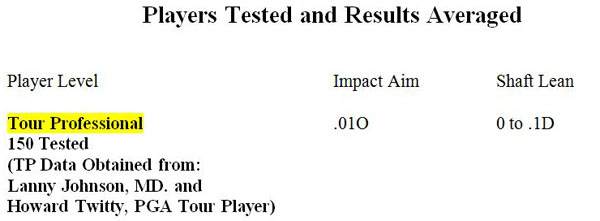
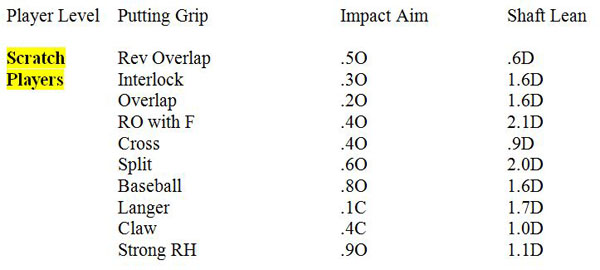

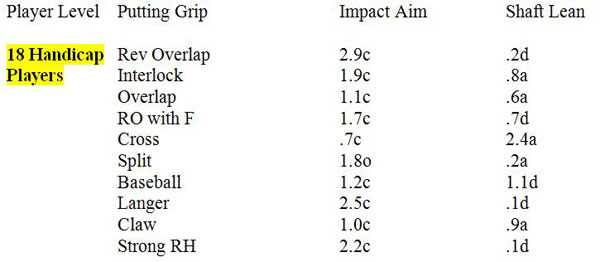



























Pingback: http://www.golfwrx.com/162633/which-putting-grip-improves-the-average-golfers-alignments/ | athletic golfer
joe sixpack
Mar 6, 2014 at 12:29 pm
I second hebron1427’s comment. Without knowing your sample size or the standard deviations there’s no way to know if your data is statistically significant.
For example, you advised Gabe to try a left hand low grip, presumably because that grip has the closest to neutral average impact aim (0.7 closed vs. 1.0-2.9 for other grips) for 18 handicap players. But what if that 0.7 figure were based on only 5 players who ranged from 3 degrees open to 5 degrees closed? If that were the case, this wouldn’t be meaningful at all.
Statistics can look powerful but without sample size and standard deviation information there is no way to tell if something like this has any validity.
Tom Stickney
Mar 6, 2014 at 9:03 pm
Understand totally however I’d advise you have fun with this article and experiment to find your own best grip.
paul
Mar 4, 2014 at 2:04 pm
I would love to see an article on how different grips for full swings makes a difference. I use a baseball style grip (smallerish hands). One plane swing and hit it with a pull. And always wondered if there was a connection. Approximately 14 handicap.
Tom Stickney
Mar 4, 2014 at 5:35 pm
Might do that. Thx.
Gabe
Mar 4, 2014 at 1:40 pm
I recently had a SAM putter fitting and the results were as follows:
Face Aim: 0.7 open
Shaft Lean: 2.0 add loft
I’m around an 18 hcp but have only been playing for 2 years. I use a traditional grip, how do I apply your data to determine a possibly better putter grip?
Tom Stickney
Mar 4, 2014 at 5:35 pm
Left hand low
Sky
Mar 3, 2014 at 9:20 pm
In general, do you want to hit up or down on a putt?
Tom Stickney
Mar 3, 2014 at 10:52 pm
Up always
hebron1427
Mar 3, 2014 at 12:36 pm
while this is interesting, it’s not particularly helpful without statistical data. did you do any statistical analysis and come up with any standard deviations on impact aim for the various handicaps? for a 36 handicap, all of these could be within the standard error.
Tom Stickney
Mar 3, 2014 at 10:54 pm
Get what you’re asking mike but this is just a general analysis of what the “average” golfer needs to experiment with in order to fix their issues